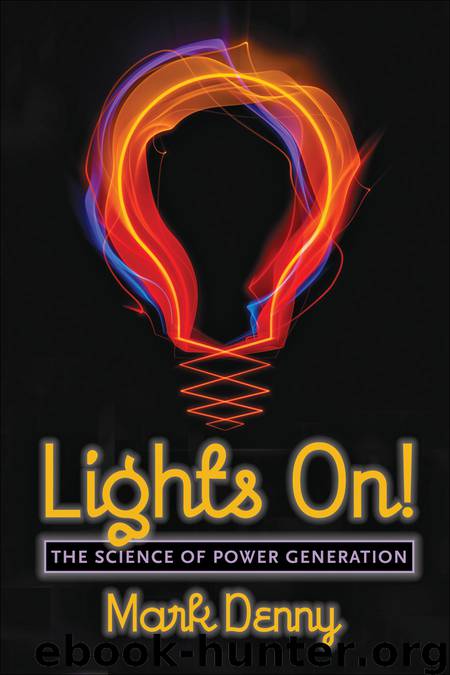Lights On! by Mark Denny

Author:Mark Denny
Language: eng
Format: epub
Publisher: The Johns Hopkins University Press
Published: 2013-03-26T16:00:00+00:00
It’s a Gas
Across the globe, we currently consume about 31 billion barrels of oil each year. Given the estimated reserves of unconventional oil, the Athabasca tar sands can supply the world for about five years and the Green River shale formation for maybe 25 years—assuming no future increase in consumption. It is very likely that consumption will increase, and so these supply numbers are optimistic. Shale and tar sands can delay peak oil but only for a matter of decades. What about that other significant fossil fuel, natural gas?
Natural gas is a sibling to oil, and therefore much of what I have said about oil applies to natural gas. Consequently, in this section I will emphasize the differences. We have seen that natural gas can be associated with oil—found in the same well—or it can be isolated (“non-associated natural gas”). Natural gas can be compressed or liquefied, and it is transported by pipeline or by tanker, as is oil. I will say something about gas pipelines, because they are not quite the same as oil pipelines. The main differences between these siblings—differences that are important for our future—are that gas is now cheaper than oil (per unit energy extracted), is more plentiful (in terms of remaining reserves), and burns more cleanly. Another difference, of geopolitical importance, is that the distribution of natural gas reserves across the nations of the world is not quite the same as the distribution of oil reserves; the largest gas field is off the coast of Qatar (the largest oil field is in Saudi Arabia), while the largest gas reserve is in Russia (the largest oil reserves are in the Middle East).
If no new conventional oil is found and if the oil consumption rate stays the same as it is today, we will run out of oil in 42 years. The equivalent figure for gas is 60 years. In energy terms the proven oil and gas reserves are about the same. Geologists estimate that the amount of recoverable oil yet to be discovered in the world equals about half the current level of oil reserves, whereas about 70% of natural gas reserves are yet to be found. I do not know how much faith to put in these figures, but the suggestion is that gas is more plentiful.
Natural gas is about 80% methane and 20% ethane, with trace amounts of propane, butane, pentane, and other hydrocarbons, plus contaminants such as sulfur. The raw product is processed to remove contaminants and condensed liquids (the gas expands and cools as it is brought to the surface, and so tends to condense), and then the different hydrocarbon constituents are separated. The natural gas we burn is pure methane, which burns cleanly. It also generates less CO2, per unit of energy released when burned, than do oil or coal. But “less” is relative here: natural gas is a fossil fuel and generates CO 2 in large amounts. Moreover, it is itself a greenhouse gas, and so leaks of natural gas are environmentally damaging.
Download
This site does not store any files on its server. We only index and link to content provided by other sites. Please contact the content providers to delete copyright contents if any and email us, we'll remove relevant links or contents immediately.
Whiskies Galore by Ian Buxton(41937)
Introduction to Aircraft Design (Cambridge Aerospace Series) by John P. Fielding(33092)
Small Unmanned Fixed-wing Aircraft Design by Andrew J. Keane Andras Sobester James P. Scanlan & András Sóbester & James P. Scanlan(32763)
Craft Beer for the Homebrewer by Michael Agnew(18196)
Turbulence by E. J. Noyes(7977)
The Complete Stick Figure Physics Tutorials by Allen Sarah(7336)
Kaplan MCAT General Chemistry Review by Kaplan(6899)
The Thirst by Nesbo Jo(6877)
Bad Blood by John Carreyrou(6581)
Modelling of Convective Heat and Mass Transfer in Rotating Flows by Igor V. Shevchuk(6406)
Learning SQL by Alan Beaulieu(6237)
Weapons of Math Destruction by Cathy O'Neil(6214)
Man-made Catastrophes and Risk Information Concealment by Dmitry Chernov & Didier Sornette(5956)
Digital Minimalism by Cal Newport;(5704)
Life 3.0: Being Human in the Age of Artificial Intelligence by Tegmark Max(5512)
iGen by Jean M. Twenge(5384)
Secrets of Antigravity Propulsion: Tesla, UFOs, and Classified Aerospace Technology by Ph.D. Paul A. Laviolette(5332)
Design of Trajectory Optimization Approach for Space Maneuver Vehicle Skip Entry Problems by Runqi Chai & Al Savvaris & Antonios Tsourdos & Senchun Chai(5037)
Pale Blue Dot by Carl Sagan(4953)
